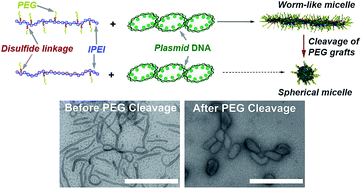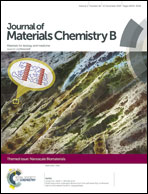Shape transformation following reduction-sensitive PEG cleavage of polymer/DNA nanoparticles†
Abstract
PEGylated polycation/DNA micellar nanoparticles have been developed that can undergo shape transformation upon cleavage of the PEG grafts in response to an environmental cue. As a proof-of-principle, DNA nanoparticles with higher PEG grafting density adopting long, worm- and rod-like morphologies, transition to more condensed nanoparticles with spherical and short-rod morphologies upon cleavage of a fraction of the PEG grafts from the copolymer. This shape transformation leads to increased surface charges, correlating with improved transfection efficiency.

- This article is part of the themed collection: Nanoscale Biomaterials

 Please wait while we load your content...
Please wait while we load your content...